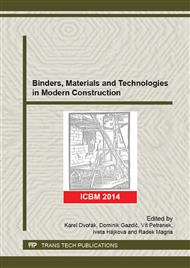p.21
p.25
p.30
p.36
p.44
p.50
p.56
p.60
p.64
High Strength Alkali Activated Slag Cements with Controlled Setting Times and Early Strength Gain
Abstract:
The paper discusses approaches to compositional build-up of high strength alkali activated cements made using water glass as alkaline activator represented by commercial products in a form of powder and liquid. The purpose was to study the influence of fineness of ground granulated blast-furnace slags, admixtures and additives, compatible with alkali activated cements, water glass and mode of manufacturing technology in order to reach high compressive strength (≥ 80 MPa at standard age (28 days)) and early strength (≥ 20 MPa after 3 h of hardening in normal conditions).
Info:
Periodical:
Pages:
44-49
Citation:
Online since:
April 2015
Price:
Сopyright:
© 2015 Trans Tech Publications Ltd. All Rights Reserved
Share:
Citation:


